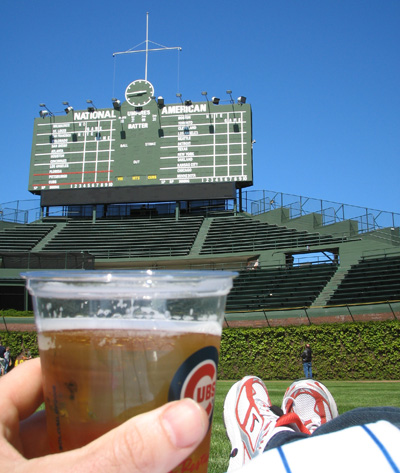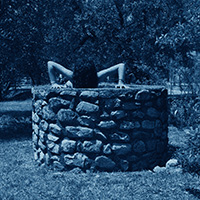“A cross between horseshoes and sodomy”
Summer in Chicago is technically over, but winter seems not to have gotten the memo and the The Greatest Ninety Days in any city seems to be rolling on.
As such, the sidewalks are alive with a simple game. It is called baggo, or bags, or bag toss, or as it is most unfortunately known around these parts: cornhole. (The bags are filled with corn kernels, you see.) Any game that enables you to play it while holding a beer in one hand and making endless sodomy jokes is bound to be good fun, no?
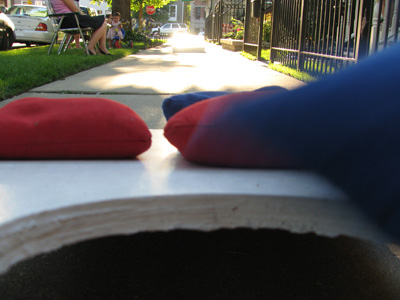
All it takes are two boards with holes, placed about 25 feet apart (the standard width of lots in the city — handy), and a couple of bags. Oh, and beer. See I believe this game was made specifically so that you could engage in a competition without putting your beer down. Which makes it perfect for tailgating and frat boys. But damn is it fun. The rules are simple: three points in the hole, one for on the board, you can knock others off, first one to 21. (There is a cancel-out variant of the rules where you have to do better than your opponent per turn to score at all, but that’s just, you know, complicated.)
But the real reason I like it is that it is an engine of social interaction for passersby. You’re blocking the sidewalk and the game makes a natural conversation point. I have met more neighbors in the past months playing baggo than I have in the past five years. Recently one evening when I was playing with my father-in-law (there’s a streetlamp right in front of our house) two drunkards spilled from the corner bar and slapped $5 on the far board. They managed to say something near “sink it in one throw.” I did. Not sure how I did, but I did.
Of course if you play on a weekend night you’re going to encounter idiots. One of the tactics in baggo involves deliberately trying to get your opponent’s bag off the board with no hope of scoring yourself. This involves an overhand throw, pitching-style. Of course, if you miss, the bag sails down the sidewalk.
This is precisely what happened a few weeks ago when, as our annual neighborhood party let out for the night, a few inebriated revelers strolled by. Can you piece together what happened next? The fellows thought we were trying to hit them. Took the bag and walked. Luckily I had a gigantic brit friend in town and he was right behind me as I negotiated the return of my precious corn-bag. Friend stared and grunted menacingly behind me, like a thug from a Guy Ritchie film. Bag returned, all OK. The magic of cornhole.
As with anything simple, it can be made less so with gadgets. Wife has not allowed me to purchase the LED tubing to light the hole at night, but damn it is tempting. And where is pimpmycornhole.com? That is money on the table, people!
You ask, all good fun, but is there a governing body of this nascent sport? But of course there is.
Post title from Stephen Colbert. Here’s the (w)hole truthiness.
“Sometimes the spaghetti likes to be alone.”
If you’ve seen the movie Big Night you’ll recognize that quote from the irascible chef Primo as he deals with 1950’s American restaurant-goers who think Italian food is spaghetti with red sauce and meatballs and nothing more.
Today of course Italian eateries are big business — from gourmet to fast food to just sucky (I worked there in college, trust me). In such a crowded space often the simplicity of homemade Italian food can be hard to find.
Anna Maria Pasteria, a small trattoria in Wrigleyville, serves uncomplicated, traditional Italian dishes. No fusion, nothing exotic. Just amazing homemade pasta, veggies, and meats. Two sisters, Maria Spinelli and Anna Picciolini, run the place and pervade it with a warmth that really is the closest thing I’ve found to the way restaurants feel in Italy. Close, comfortable, happy. And the service matches the food. Not showy, but ample.
Anna and Maria are originally from Ripacandida, Italy a small, hill-topping down about 15 minutes from Barile, my destination on Friday. Though the menu runs the gamut of Italian dishes that just about anyone would recognize, the sisters do make southern fare. These plates are invariably simple: pasta, a light sauce with herbs, and a meat. (Try the Pollo ai pignoli or the Capellini carrettiera.) Anna Maria Pasteria also serves a heavenly Tiramisu. Lighter than air.
A great send-off dinner before we embark for Italy. Highly recommended.
Urban oasis
A few years after the Wacker Drive demolition and rebuild the little Vietnam Memorial plaza on the Chicago River is open for passersby. Between State and Wabash on the south side. It isn’t exactly a full-on riverwalk, but it does make the waterway seem less like a gulch. Really quite nice.
This is right across from the former location of IBM in Chicago. Makes me miss the area all the more. What a great place it would have been to get away from the office hubbub. Might have even been able to rig a Wifi repeater to shoot across the river. Oh well. I’ll just sulk in the skyscraper canyon we’re now in.
For Chicago River fans out there, here’s a video of me taking the water taxi east on the main branch to the Michigan Avenue quay.
Sluicing through the blog archives I am struck at my obsession with this river. Go with the flow:
Brita City (re-engineering the river)
Escher streetscape (watching the drawbridges let sailboats in)
A unique phone call (floating past a bridge on fire)
Tipping Point (the Eastland disaster)
Available: loft apartment w/ lake and river view (man who lived in the Michigan Ave. bridge)
Man vs. sailboat (outrunning the drawbridges)
Beauty in the breakdown
Not sure why it has taken me to so long to upload this, but here’s a great time-lapse video from the winter of 2004-2005 of the deconstruction of the Sun-Times building from the IBM building. A monument to the pre-Trump era.
Thanks to Jack Blanchard and Jeff Berg.
Man, I miss that view.
Roof, raised
Continuing down the checklist of things I’d like to see/do at Wrigley Field (lounge in the outfield, check; witness drubbing of Sox in crosstown match, check), Tuesday night was my first game viewed from a building rooftop outside the park. Those of you who don’t follow baseball may not know that Wrigley, being a 93-year-old urban ballpark, is tightly surrounded by a residential neighborhood. Three-flats line left and right field and, except two that display advertising, each of these buildings have for years hosted private groups on their rooftops. It is a unique vantage, this outsiders’ view inside.

I remember watching a game with my grandfather in the late 70’s when Bill Buckner hit a home run out of the park and shattered a window in one of the buildings. I thought, wow, someone is going to come home from work and find a great surprise. Of course, these days very few come “home” to these buildings. The homes have been almost completely taken over by the “clubs” which perch atop them. Many are owned by local bars, nearly all are managed by the same company. (After a nasty battle involving the erection of screens to partially obscure the view from the roofs most of the clubs agreed to give the Cubs 17% of their revenue annually.) There’s one private club too. A few years ago my wife tried to get tickets for me up on a roof for my birthday. It was next to impossible because the roofs are really for groups, corporate outings, and the like. Sorta like a skybox, except across the street.
I was invited by a friend who was in with some Chicago society of CPAs. Yes, I was on a Wrigleyville rooftop with a bunch of accountants: good times! I tried to keep out of conversations — which was easy given the free beer and food and the fact that I was there to watch a baseball game. And that’s the thing about the rooftops. Many people hardly notice what’s going on in the ballpark. (It is, in that way, very much like a skybox.) Most are corporate types, many are not Cubs fans or even baseball fans. Of course, you get this in the park too, but on a rooftop quarters are tight — tighter than I imagined — and you’re kinda stuck with these folks.

The rooftops all have high-def TV’s sprinkled around, but the broadcast delay makes it almost useless for anything but replays. I was grabbing a beer in an area where I could not see the park and I heard a cheer go up. I looked up at the screen and the camera was on the pitcher, scratching himself. To make matters worse the audio is off and they are playing the radio coverage of the game, which has no delay.
The view is great though. Not that much worse than some of the cheap seats in the upper deck. The only thing you can’t see is activity on the track near the ivy. But you use the cheers or sighs from the bleacher bums to determine what happened there. And of course it is just fun conceptually: I’m watching a live baseball game and I’m not in the park.
In the end I suppose the idea is a bit better than the experience. Of course, I didn’t pay for the ticket (which was at least $90) — and perhaps it would have been more fun with a roof full of friends — so I can’t complain really. It just wasn’t the raucous time that the park delivers. I think I’d rather be inside.
Pass it down
Saturday I attended possibly the most enjoyable baseball game I have ever seen in person. My father-in-law was in town. Our family schedule parted as miraculously as the Red Sea and living within walking distance of the park, I proposed going to see the Cubs versus our crosstown rivals the Sox. Nevermind that we didn’t have tickets. Nevermind that it was the nicest day for a baseball game all season. Never mind that it was the first series with the Sox. We figured we’d get taken by scalpers, but in fact the Cubs have a licensed reseller (read: official scalper) selling gameday tickets on location. We got tix four rows from the field on the Cubs side. Cost: um, more than face.
It was perfection. Suffice to say that the wind was blowing out, no one held a lead for very long, and a certain beloved Lee (not Elia, bless his profane heart) who was on the bench with a neck spasm emerged from the dugout to bewildered but deafening applause, whiffed once, sat on three, and then smacked one into the bleachers. Oh, also the bases were loaded. (A pinch hit grand salami, for goodness sake. Can anyone tell me the last time that happened with the Cubs?) Good times.
But what I really want to talk about here is drinking beer at Wrigley. Admittedly I’ve only been to a few other parks in my life, but I have to think the culture of beer is stronger in The Friendly Confines. Hell, it is the only park to have baseball cards for every single beer vendor.
So there’s a whole set of unwritten rules regarding buying from beer vendors at Wrigley. Here is the obligatory How To (Digg front page, here I come!):
- Yell “Hey Old Style!” like you’re picking a fight or sheepishly flag down the Bud guy.
- As he works his way up or down the rows serving other fans remind him of your order periodically by throwing peanuts his way and waving the number of beers you want his direction. Actually, don’t throw peanuts.
- When he gets to your row he’ll normally hold his index finger and thumb like he’s holding your ID. This means send it down the row.
- Do the math. $6 times the number of beers requested. Pass this and a little more plus your ID to the person next to you for delivery down the row.
- Watch as every person handles your ID, looks at your photo, and basically learns who you are.*
- Wait for the beers to be passed down to you while enduring the obligatory “sip charge!” heckling from those having to pass them.
- Flash the number of dollars you want back, implying the tip, to the vendor. Remember, he has your ID and he hasn’t spit in your beer (yet).
- Enjoy beer.
[*] Does anyone find it odd that the park is now carding people this way? I’m not opposed to enforcing the age limit, but in what other circumstance would I be forced to put one of my most important identification documents in the hands of a row full of total strangers? Privacy nuts are obviously not ballpark beer drinkers.
To make matters worse, my ID is actually cracked at the top from where the top of it pokes out of the sleeve in my wallet. Apparently consistent ass-pressure over the years has made it so. The vendor in the stands told me that he couldn’t sell me another one with an ID like that and, sure enough, when I went to get more after a potty break under the stands I was rejected. (Luckily, a nearby seatmate stranger — part of an earlier pass-the-money pass-the-beer bucket brigade — was in line right next to me. So he bought my beer.) But still, the policy is no altered, broken, or frayed ID’s will be accepted. Altered, ok. But broken or frayed? Do they think we keep our ID’s in some kind of Centers for Disease Control white room? It is under our ass 70% of the day, for god’s sake!
I’ll leave you with the completely unrelated but absolutely hilarious rant by the Sox head coach, Ozzie Guillen, the day the series started. Idiot.
Wrigleyvillage
When it comes to Wrigley Field lots of people talk about how great it is to see a ballgame smack in the middle of a vibrant neighborhood. Not as many talk about what this means for the neighbors. It is of course a boon to the merchants and businesses in very close proximity to the field, but the neighborhood also serves as the stadium’s parking lot (the only one, really) and as a mile-square urinal for the ocean of over-served fans who spill out at game’s end.
The Cubs have in recent years made a special effort to win the good will of the people who live in the community, specifically the area known as Lakeview. This includes spiffing up local parks, appearances of hall of fame players in the area, and free bike lock-up for games. But the coolest perk has to be Wrigleyville Neighbors Day. Each year the Cubs hold a lottery for residents in Lakeview to come to the park for 90 minutes of free food and drinks (alcohol too) and to play catch, picnic, or just lounge on the field. We’ve lost out the last two years but got it this year. One person per address plus guest. I took my son.
We were close to the front of the line of about 100 people so when we entered the field from the service door in the outfield it was like the park was ours alone. We ran out onto the grass with our mitts, one five-year-old boy and his five-year-old father. At first we just ran around because we could. We played catch. We ran the bases (four times) and just lounged in the outfield. It was extraordinary. A wonderful, memorable way to spend an afternoon. Thanks, Cubs. Well done.
Calling him out
This is classic.
From ChicagoSports.com:
The Lilly-Piniella incident was one for the books. Lilly [the pitcher] had slipped on a bunt attempt for the second time when Piniella [the coach] gave him some unsolicited advice.
[Lilly recalls the walk to the mound.] “I suggested to him, almost like football, ‘You better change your spikes,’ ” Piniella said. “Then I went out there and he said, ‘Skip, your zipper is down.’ ”
A quick check by Piniella revealed Lilly was correct.
If you’re gonna get yanked from the game for sucking you might as well needle the man in charge, no?
And if you’re wondering where all the posts have gone of late, fear not. The Italy adventure is consuming much of my time … and soon will yours.
Brita city
Bioswales, blackwater, and benthic nets. Microbial fuel cells, hydroponic disinfection, and pervious pavement.
Were you thinking about these things when you were in college? I certainly wasn’t. Perhaps I should have been, because the student teams in the History Channel’s City of the Future Engineering Challenge sure seem like they have bright futures ahead.
Picking up on the popularity of their “Engineering an Empire” series, the History Channel last year held a design competition in LA, Chicago, and NYC. Professional design teams had one week to design a vision of their city 100 years in the future in such a way that would be sustainable much beyond.
The winner in Chicago was Urban Lab, a small outfit on the south side whose Growing Water submission presented a Chicago infrastructure that recycles 100% of the water it needs by un-reversing the flow of the Chicago River back into Lake Michigan, resurrecting the (currently) century-old idea of an Urbs in Horto “Emerald Necklace” of parks ringing the city proper, and carving latitudinal waterways alongside “eco-boulevards” to make the whole city-sized water filter work.
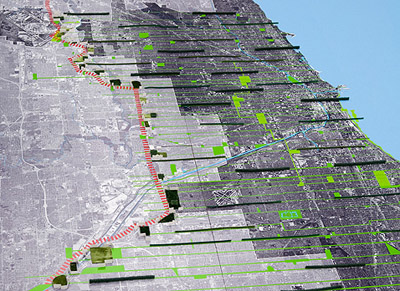
That was sorta the easy part. The heavy lifting was left for the students in the second phase who actually had to present the engineering behind it all. As a sponsor of the event (with a keen interest in promoting engineering, math, and science) IBM was asked to provide a judge for the second phase. This was me. I was elated. I wasn’t at all qualified, but I have been writing about the subcontinental divide, reversed river, and future Chicago here for a long time. The blog as street cred.
Undergraduate engineering student teams were fielded by the Milwaukee School of Engineering, Purdue University, U of I Urbana-Champaign, two from U of I Chicago, and Northwestern University. The presentations were simply remarkable. These kids — and they were kids to be sure — had put an amazing amount of time and thought into the tricky real-world problems of re-architecting a city at its most basic level. None of this was done for course credit.
Prior to the presentations the judges received ample supporting documentation for each solution: dozens of pages of equations backing up claims, diagrams, 3D renderings, and a bounty of specialized words to make the verbophile delight for hours. Advective. Biomimicry. Turbidity. Effluent. I loved it all.
The essence of the challenge in engineering Urban Lab’s design was how to design the filtration of the water in the terminal parks and along the eco-boulevards east of the subcontinental divide. Most of the teams focused on how this filtration would happen. Others also stressed the challenge of separating graywater (wastewater with everything but poop), blackwater (poop), and potable water while being able to accommodate the “100-year-storm” (Chicago, though above sea level, is essentially a swamp). Still others focused on the Urban Lab sidenote that existing santitation tunnels (not needed in their design) could be used for expanded mass transit. One team went into great detail about a Chicago Maglev train. This might be a great next project for the CTA as their current Brown Line expansion will likely finish up around 2106.
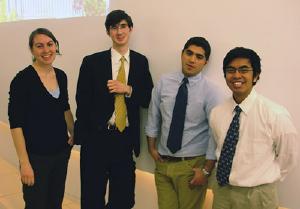
The team from UIUC won the competition with their notion of EcoTowers — residences at the terminus of eco-boulevards that pass graywater through a “biomimetic forward osmosis membrane bioreactor.” Duh. Of course they do. The towers themselves provide further filtration by running a curtain of nearly-clean water down the windows of the highrises for UV disinfection. Like living under a waterfall or inside the Beijing Olympic natatorium. Brilliant.
Chicago has a very long way to go to approach anything like this design, of course. Green roofs are a start, I suppose. Just glad people are working the problem. Even more glad that career-minded students are taking it so seriously. Bravo to all the teams.
See also on Ascent Stage: City of the Future and 10 Visions, an exhibition from the Art Institute
Move it, sugar!
Remember the Urban scar tissue post? No, of course you don’t.
Well, it was about the way cities have of slowly assimilating unused infrastructure and how this becomes visible when you scale out, looking at the city macroscopically. The earlier post showed the way the buildings have been shaped by the tracks that are no longer there, a ghost-limb of transportation past.
But the very southern edge of the line is still in use. Twice weekly. It is called the Sugar Train and it delivers sugar to a confectionary. The tracks, embedded nearly flush with the pavement sans sleepers, slice through private backyards and parking lots. My gym prohibits parking on the tracks tuesdays and thursdays because of the delivery. Up until last week I had never seen this mythical train.
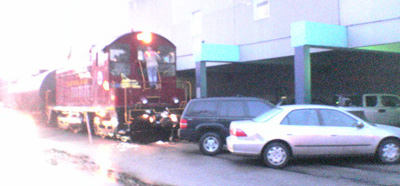
Turns out this delivery route is a fantastic pain in the ass for everyone involved. There’s a small army of engineers that walks with the engine and single car as it creeps through the north side. Gates have to be unlocked, backyard equipment pushed aside, and — in the case of my gym — owners of cars have to be found. Seems that twice a week the train comes to a stop at the club while the management goes elliptical-to-elliptical asking people if they parked on the tracks.
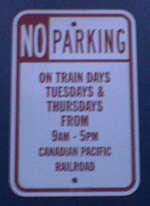
I stood outside with clearly-irritated trainmen as the massive engine belched and growled, mere inches from a car parked directly across its path. I struck up a conversation and urged them to exercise right-of-way, crushing the pathetic vehicles like matchbox cars. They declined. In fact, they eventually gave up and backed the train down the tracks to who-knows-where.
I love that this throwback train exists, but you have to wonder: wouldn’t it be easier to deliver the sugar by truck at this point? The train basically spends a full day inching through roadblocks that the city inadvertently lays across its way. I’d love to know what the actual story is. Why the train is still a better option for the candy factory.


